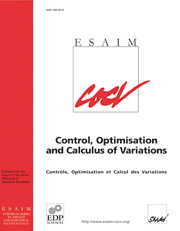Article contents
A Posteriori Error Estimation forReduced-Basis Approximation of Parametrized Elliptic Coercive Partial DifferentialEquations: “Convex Inverse” BoundConditioners
Published online by Cambridge University Press: 15 August 2002
Abstract
We present a technique for the rapid and reliable prediction oflinear-functionaloutputs of elliptic coercive partial differential equations with affineparameter dependence. The essential components are (i )(provably) rapidlyconvergent global reduced-basis approximations – Galerkin projectiononto a spaceW N spanned by solutions of the governing partial differentialequation at Nselected points in parameter space; (ii ) a posteriori error estimation– relaxations of the error-residual equation that provideinexpensive bounds for the error in the outputs of interest; and (iii ) off-line/on-line computational procedures – methods whichdecouple the generationand projection stages of the approximation process. The operationcount for theon-line stage – in which, given a new parameter value, we calculatethe output ofinterest and associated error bound – depends only on N (typicallyvery small) andthe parametric complexity of the problem; the method is thus ideallysuited for therepeated and rapid evaluations required in the context of parameter estimation,design, optimization, and real-time control. In our earlier work we develop a rigorous a posteriori error bound framework for reduced-basisapproximations of elliptic coercive equations. The resulting errorestimates are, in some cases, quite sharp: the ratio of the estimatederror in the output to the true error in the output, or effectivity , is close to (but always greater than) unity. However, inother cases, the necessary “bound conditioners” – in essence,operator preconditioners that (i ) satisfy an additional spectral“bound” requirement, and (ii ) admit the reduced-basisoff-line/on-line computational stratagem – either can not be found, oryield unacceptably large effectivities. In this paper we introduce a newclass of improved bound conditioners: the critical innovation is thedirect approximation of the parametric dependence of theinverse of the operator (rather than the operator itself); wethereby accommodate higher-order (e.g., piecewise linear) effectivityconstructions while simultaneously preserving on-line efficiency. Simpleconvex analysis and elementary approximation theory suffice to prove thenecessary bounding and convergence properties.
Keywords
Information
- Type
- Research Article
- Information
- ESAIM: Control, Optimisation and Calculus of Variations , Volume 8: A tribute to JL Lions , 2002 , pp. 1007 - 1028
- Copyright
- © EDP Sciences, SMAI, 2002
References
- 42
- Cited by

